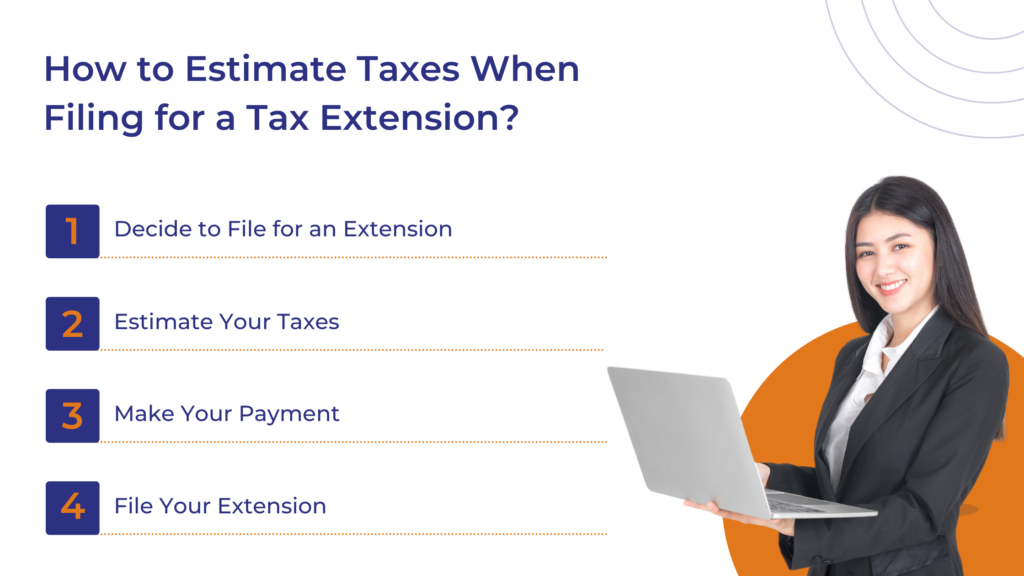Taxes are an unavoidable aspect of earning an income. For those employed by a company, the process is streamlined through payroll deductions, where a portion of each paycheck is withheld and remitted to the government. This way, you pay your taxes bit by bit throughout the year. And if you’re lucky, you might even get some money back when tax season rolls around.
But what if you work for yourself or earn money from other sources, such as investments or a side business? That’s where estimated tax payments come in.
If taxes are not automatically deducted from your pay, you’ll need to estimate your income and the taxes you owe, then send the payments to the IRS at specific intervals during the year. This blog will help you determine if you need to pay taxes when to pay, and how to do it.
What are Estimated Tax Payments?
Estimated tax payments allow you to pay taxes on income that doesn’t automatically have taxes withheld, such as earnings from self-employment, side gigs, dividends, capital gains, and prizes. You’ll likely need to make these payments to the IRS throughout the year.
For those who receive a regular salary, the tax withheld from your paycheck is based on the information you provide on your W-4 form to your employer. If not enough tax is withheld, you might need to make estimated tax payments to avoid owing a large sum at tax time.
Due Dates for Estimated Tax Payments in 2024
The IRS requires estimated tax payments to be made quarterly. It’s important to know the deadlines to avoid penalties. While the IRS sets four main deadlines for estimated tax payments, you have the flexibility to make payments more frequently.
For example, you could make monthly payments instead of four larger payments, making it easier to manage your cash flow throughout the year. For the 2024 tax year, the estimated tax payment deadlines are as follows:
- For income earned from January 1 to March 31, 2024: Payment is due by April 15, 2024.
- For income earned from April 1 to May 31, 2024: Payment is due by June 17, 2024.
- For income earned from June 1 to August 31, 2024: Payment is due by September 16, 2024.
- For income earned from September 1 to December 31, 2024: The final payment is due by January 15, 2025.
If you earned income between September 1 and December 31, 2023, that quarter’s estimated tax payment deadline was January 16, 2024. However, if you filed your 2023 tax return by January 31, 2024, and paid the full amount owed with your return, you didn’t need to make this estimated payment separately.
Who Needs to Make Estimated Quarterly Tax Payments?
Here is the list of all those who need to make estimated quarterly tax payments:
1. 1099 Workers: This includes independent contractors, freelancers, and people with side gigs. You should make estimated tax payments if you expect to owe $1,000 or more in taxes and don’t have taxes withheld from your income.
2. W-2 Workers with Insufficient Withholding: If your job doesn’t withhold enough taxes to cover your tax bill, you might need to make estimated payments. This is likely if:
- After subtracting your withholdings and credits, you’ll owe $1,000 or more in federal income taxes this year.
- Your withholdings and credits are less than 90% of this year’s tax or 100% of last year’s liability (110% if your adjusted gross income was more than $150,000 or $75,000 if married filing separately).
3. Businesses: Corporations that expect to owe at least $500 in taxes for the year must make estimated payments.
4. Landlords and Investors: If you have rental income or investments, you might need to pay estimated taxes, even if you have a regular job that withholds taxes.
To determine if you need to make these payments, ask yourself:
- After accounting for your withholdings, will you owe less than $1,000 in taxes for the year? If so, you don’t need to make estimated payments.
- Will your withholdings cover at least 90% of this year’s tax liability or 100% of last year’s? If yes, you’re likely exempt from making estimated payments.
- For high earners with an adjusted gross income over $150,000 ($75,000 if married filing separately), will your withholdings cover at least 110% of last year’s tax? If so, you don’t need to make estimated payments.
If you answered no to these questions, you should make estimated tax payments using Form 1040-ES to avoid penalties.
How to Calculate and Pay Your Estimated Taxes?
Here is how to calculate your estimated taxes:
1. Choosing the Right Amount to Pay
Paying at least what you owed in taxes last year is a safe strategy to avoid penalties. If your income was more than $150,000 last year (or $75,000 if you’re married and filing tax separately), you should pay 110% of it.
If you anticipate earning less this year, you can pay 90% of your estimated taxes, preventing you from overpaying. However, be careful not to underpay, as falling below 90% could lead to penalties. If you expect to earn more this year, you should aim to cover 100% of your estimated tax liability to avoid owing taxes when you file your return.
2. Review Last Year’s Return
Examine the income, deductions, and taxes paid last year. This will give you a baseline for your calculations.
3. Estimate Annual Income & Deductions
Predict your income and deductions for the current year to calculate your estimated tax liability.
4. Use a Worksheet
Use the worksheet in Form 1040-ES to help with your calculations. This can guide you through estimating your income, deductions, and the taxes you owe.
5. Subtract Withholdings and Payments
Deduct any taxes already withheld from your paycheck and any estimated tax payments you’ve made from the total tax you estimate you owe.
6. Pay Your Estimated Taxes
You can pay your estimated taxes online through your IRS account, the IRS2Go app, IRS Direct Pay, or the Electronic Federal Tax Payment System (EFTPS). You can also pay by debit or credit card, in cash at IRS retail partners, or by mailing a check with Form 1040-ES.
Following these steps can help you determine how much you must pay in estimated taxes to avoid penalties. It is always better to be cautious and overestimate a little than to underestimate and face penalties.
How to Estimate Taxes When Filing for a Tax Extension?

If you need more time to prepare your tax return, you can file for a tax extension for an extra six months. However, remember that this extension only gives you more time to file your paperwork, not to pay your taxes. To avoid penalties from the IRS, estimate and pay any taxes you owe by the original tax deadline. Here are simple steps to determine.
Step 1: Decide to File for an Extension
If April 15th is approaching and your tax return isn’t ready, don’t panic. You can file for an automatic six-month extension. This will move your filing deadline to October 15th. But remember, this doesn’t extend the time you have to pay your taxes.
Step 2: Estimate Your Taxes
Use the Estimated Tax Worksheet in IRS Form 1040-ES to determine your owed amount. This form will guide you through estimating your income, deductions, and taxes.
Step 3: Make Your Payment
Once you’ve estimated your tax liability, you can pay what you owe online, by phone, or by mail. Submit your payment by the original April 15th deadline to avoid penalties and interest.
Step 4: File Your Extension
Don’t forget to file for your extension officially. You can do this electronically through tax software, with the help of a tax professional, or by mailing in Form 4868. If you do this by the tax deadline, you’ll have until October 15th to file your tax return.
Additional Tip: If you estimate your taxes and find you can’t pay the full amount, it’s still important to file for an extension and pay as much as possible. The IRS offers payment plans for those who need more time to pay their tax bill. This can help reduce or avoid penalties and interest.
What Happens If You Don’t Pay Estimated Taxes?
If you don’t pay estimated taxes, you might have to pay a penalty in addition to the taxes you owe. The penalty amount depends on the amount of tax you owe and how long you’ve owed it. Not paying on time means you could owe the IRS more when filing your tax return. It’s best to pay your estimated taxes in four equal parts throughout the year. However, there are times when your payments might not be equal:
- If you apply last year’s tax overpayment to this year’s taxes.
- If you start making payments after the first deadline in April.
- If you unexpectedly earn more money in one part of the year.
For example, if you need to pay $10,000 in total and miss the April payment, you might pay $5,000 in June, then $2,500 in September and January. But you could still face a penalty for missing the April deadline. To avoid penalties, try to pay your estimated taxes on time and in equal amounts. If you can’t make a payment or start late, adjust your payments accordingly, but be aware of potential penalties for any missed or late payments.
Simplify Your Tax Filing with TruePro Associates

At TruePro Associates, we offer comprehensive services tailored to meet your unique tax needs. Our income tax services and accounting services are customized to provide comprehensive support for personal and business tax needs.
Why Choose TruePro Associates?
- Expertise You Can Trust: Our team comprises seasoned tax professionals who stay current on tax laws and best practices.
- Customized Solutions: We understand that every tax situation is unique. We take the time to understand your specific circumstances and tailor our services accordingly.
- Transparent Pricing: We discuss our fees upfront, ensuring you understand the value of the services you receive.
Schedule a consultation and learn how we can assist you in achieving your tax and financial goals.
FAQs
Q1. Who needs to make estimated tax payments in 2024?
Ans. You likely need to make estimated tax payments if you earn income not subject to tax withholding, like money from self-employment, side jobs, dividends, or capital gains. This includes freelancers, independent contractors, and small business owners.
Q2. When are the estimated tax payments due in 2024?
Ans. Estimated tax payments are due in four installments: April 15 for income earned from Jan 1 to Mar 31; June 17 for income earned from Apr 1 to May 31; September 16 for income earned from June 1 to Aug 31; and January 15, 2025, for income earned from Sep 1 to Dec 31, 2024.
Q3. How can I pay my estimated taxes?
Ans. You can pay your estimated taxes online through your IRS account, the IRS2Go app, IRS Direct Pay, or the Electronic Federal Tax Payment System (EFTPS). You can also pay by debit or credit card, in cash at IRS retail partners, or by mailing a check with Form 1040-ES.
Q4. What if I don’t make my estimated tax payments?
Ans. Not paying your estimated taxes can result in a penalty on top of the taxes you owe. The penalty is based on the amount and length of time you owe.
Q5. Can I pay my estimated taxes in unequal amounts?
Ans. Yes, your payments might not be equal if you apply last year’s overpayment to this year’s taxes, start making payments after April 15, or earn significantly more in one quarter. However, be mindful of deadlines to avoid penalties.







